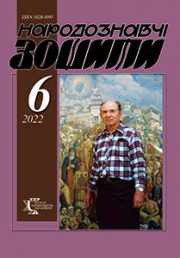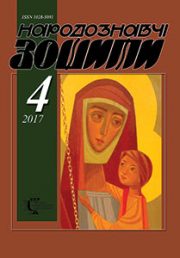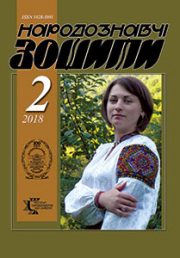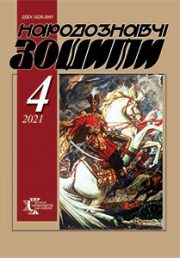The Ethnology Notebooks. 2023. № 3 (171), 586—596
UDK 398.47(161.2):159.962/.963
REALITY OF «IRREAL»: PROGRAMMING FUNCTIONS OF DREAMING IN THE MAGIC OF SUGGESTION (A STUDY OF TRADITIONAL CULTURE OF UKRAINIANS)
TEMCHENKO Andriy
- ORCID ID: http://orcid.org/0000-0003-3999-9459
- Candidate of Historical Sciences, Associate Professor,
- Associate Professor of the Department of the Ukrainian History
- of the Bohdan Khmelnytsky National University of Cherkasy,
- boulevard of Shevchenko, 81, Сherkasy, 18000, Ukraine,
- Contacts: e-mail: temchen@ukr.net
Abstract. Introduction. The programming functions of dreaming in the magic of suggestion are analyzed in the article.
The purpose of the publication is highlighting of the semantic connections between dreams, myth and reality, as well as an attempt of the meaningful reconstruction of rites with elements of hypnosis.
Research methods involve the use of such means of scientific knowledge that are used in related fields, namely: Psychology, Linguistics, History, Philosophy, Cultural Anthropology.
The results obtained. In the «everyday» worldview, dreaming is perceived as a reaction of the psyche to everyday activities, but in traditional culture it can form its «agenda». So, dreaming can not only reboot the system, but in a certain way reprogram its functionality. The property of the psyche for programming and self-programming can be arbitrary and adjustable. Voluntary rebooting is associated with the psychophysical functions of dreaming (restoration of resources, processing of information, compensation of unfulfilled desires and needs, adaptation of the psyche to new conditions).
In traditional culture, there are ritual mechanisms by means of which regulated suggestion takes place in a limited mode. The corresponding practices resemble the methods of directive hypnosis used by Ukrainian women in relation to their husbands. An important feature of such practices is the determination of the time and place of the ceremony. The nights from Thursday to Friday and from Saturday to Sunday were considered to auspicious, which is due to the mythological semantics of these days of the week. The purpose of performing the relevant rites is to visualize the necessary dream image, with the help of which the behavioral model of a marriage partner, which is necessary for a post somnum woman, is created. The application of magical practices with elements of hypnosis involves the creation of subject installations that functioned as a kind of communication portals associated with the semantics of water (wells, bridges) that were supposed to teleport the dreamer’s secret aspirations. The objectification of the «imaginary» strengthens the effect of the ritual in the sense of more effective suggestion, as it stimulates the suggestion of the person who / with whom the corresponding manipulations are carried out. The corresponding actions were not a common phenomenon and related mainly to female reproductive magic aimed at keeping or attracting «her» husband.
Keywords: hypnosis, a well, magic, a bridge, a myth, simulation, suggestion, a rite, subconscious, psyche, Friday, reproduction, a ritual, a dream, a stereotype, Saturday, enchantment, Thursday, marriage, déjа vu.
Received 24.04.2023
REFERENCES
- Ivanov, V.V. (1998). Odd and Even. Asymmetry of the Brain and Dynamics of Sign Systems. In Ivanov V.V. Selected Works on Semiotics and Cultural History. Sign Systems. Movie. Poetics (Vol. 1, pp. 381—602). Moscow: School «Languages of Russian Culture» [in Russian].
- Garces-Foley, K. (2005). Death and Religion in a Changing World. London: Routledge.
- Kamau, C. (2013, june). What Does Being Initiated Severely into a Group Do? The Role of Rewards. International Journal of Psychology, 3 (Vol. 48).
- Pustovalov, S.Zh. (2006). Rites of Passage and Catacomb Burial Ritual. Scientific Notes of NaUKMA. Theory and History of Culture (Vol. 49, pp. 62—67). Retrieved from: https://ekmair.ukma.edu.ua/server/api/core/bitstreams/7ba0b651-6176-4d83-a527-17043e23c969/content (Last accessed: 12.03.2023) [in Ukrainian].
- Naumovska, O. (2022). The Invariant Structure of Rites of Transition between Worlds in the Scientific Understanding of Arnold Van Gennep. Bulletin of Taras Shevchenko Kyiv National University. Literary Studies. Linguistics. Folkloristics, 1 (31). Retrieved from: https://philology-journal.com/index.php/journal/article/download/58/51 (Last accessed: 12.03.2023) [in Ukrainian].
- Vdovchenko, S. Death and Birth: Rites of Passage in Ukrainian Folk Tales. Verbum, 41: Time of Transition. Retrieved from: https://www.verbum.com.ua/08/2019/time-of-transition/the-rites-of-transition-in-ukrainian-fairytales/ (Last accessed: 12.03.2023) [in Ukrainian].
- Honcharuk, V.A., & Orel, M.V. (2018). Theory of Rtes of Passage: Historical Aspect. Philological Sciences: Modern Trends and Development Factors: International Scientific and Practical Conference, Odesa, January 26—27, 2018. Odesa: Southern Ukrainian organization «Center for Philological Research». P. 87—90. Retrieved from: https://dspace.udpu.edu.ua/xmlui/handle/6789/8555?show=full&locale-attribute=ru (Last accessed: 14.03.2023) [in Ukrainian].
- Dmytriuk, V. (2019). Photo-Folkloric Aspects of Modern Rites of Passage: from Private to Public Practices: on the materials of Odeshchyna. Ethnological Notebooks, 5 (149), 1274—1285. Retrieved from: https://nz.lviv.ua/archiv/2019-5/25.pdf (Last accessed: 16.03.2023) [in Ukrainian].
- Mayerchyk, M. (2011). Ritual and Body: Structural and Semantic Analysis of Family Cycle Rites. Ukrainian Institute of Harvard University; National Academy of Sciences of Ukraine: Institute of Folklore; Institute of Criticism; Center for Cultural and Anthropological Studies. Kyiv: Krytyka [in Ukrainian].
- Boryak, O. (2009). The Midwife in the Cultural and Historical Tradition of Ukrainians: between the Profane and the Sacred. Kyiv: Institute of Art History; Folklore and Ethnography named after M.T. Rylsky of National Academy of Sciences of Ukraine [in Ukrainian].
- (1992). Secret power of words (charms, spells). Kiev: Znannya [in Ukrainian].
- Chubynsky, P. P. (1995). The Wisdom of the Ages. Ukrainian Ethnography in the Creative Heritage of Pavlo Chubynsky: in 2 vol. (Vol. 1). Kyiv: Art [in Ukrainian].
- Hypnosis: fiction or reality? Retrieved from: http://www.rusnauka.com/40_NNM_2015/Psihologia/7_201951.doc.htm (Last accessed: 15.03.2023) [in Ukrainian].
- Malinowski, J.E., & Horton, C.L. Dreams Reflect Nocturnal Cognitive Processes: Early-Night Dreams are More Continuous with Waking Life, and Late-Night Dreams are More Emotional and Hyperassociative. Retrieved from: https://www.sciencedirect.com/science/article/abs/pii/S1053810020305389 (Last accessed: 16.03.2023).
- Aamodt, S., & Wang, S. (2009). Welcome to Your Brain: Why You Lose Your Car Keys but Never Forget How to Drive and Other Puzzles of Everyday Life. New York: Bloomsbury.
- Witkowski, Sadie. How Sound and Smell Cues Can Enhance Learning while You Sleep. Edited by Pam Weintraub. Retrieved from: https://aeon.co/ideas/how-sound-and-smell-cues-can-enhance-learning-while-you-sleep (Last accessed: 22.03.2023).
- Temchenko, A.I. (2014). Traditional Orders: Semantic Transformations and Ritual Paradigms: Monograph. Cherkasy: IntroligaTOR [in Ukrainian].
- Myloradovych, V.P., & Talanchuk, O.M. (Ed.). (1992). Ukrainian Secret Knowledge and Charms. Ukrainian Charms (Pp. 5—13). Kyiv: Lybid [in Ukrainian].
- Yudin, K. To Metaphysics of Dreams. Retrieved from: https://www.gumer.info/bibliotek_Buks/Psihol/Article/Jud_MetSn.php (Last accessed: 7.04.2023) [in Russian].
- Hobson, Allan. (2004). 13 Dreams Freud Never Had: The New Mind Science Hardcover.
- Potebnya, A.A. (1989). The Word and the Myth. Moscow: Pravda Publishing House [in Russian].
- Bilyi, V., & Loboda, A. (Ed.). (1930). Tales of the Ukrainian Dyers. Ethnographic Bulletin (Book 9, pp. 53—95) [in Ukrainian].
- Tereshchenkova, S.M., & Loboda, A. (Ed.). (1930). Tales of Dying (Recorded in Zvinyhorod District). Ethnographic Bulletin (Book 9, pp. 97—109) [in Ukrainian].
- Afanasyev, A.N., Pomerantseva, E.V., & Chistov, K.V. (Eds.). (1985). Folk Russian Fairy Tales: in 3 vol. (Vol. 2). Moscow: Nauka [in Russian].
- Fasmer, M., Trubachev, O.N., & Larin, B.A. (Ed.). (1986). Etymological Dictionary of the Russian Language: in 4 vol. (Vol. 2 (Е—Муж). Moscow: Progress [in Russian].
- Temchenko, A. (2015). Semantics of the Days of the Week: Thursday in the Mythological Representations of the Slavs (a Study of Orders). Folk Creativity and Ethnography, 3, 28—34 [in Ukrainian].
- Kysil, I. (1995). Transformation of Ancient Slavic Mythology in Modern Slavic Languages. Materials for Ukrainian Ethnology. Kyiv: Institute of Art History of Folklore and Ethnology named after M.T. Rylsky of National Academy of Sciences of Ukraine (Issue 1 (4), pp. 338—340) [in Ukrainian].
- Demchyk, I.L. (2013, november). Dialect Ideographic Dictionary: Features of Arrangement and Construction. Science and Education: a New Dimension: Philology, I (2). (Issue 11). Retrieved from: https://scholar.googleusercontent.com/scholar?q=cache:W3rSMtGLMU8J:scholar.google.com/+%D1%87%D0%B5%D1%82%D0%B2%D0%B5%D1%80%D0%B3+%D1%81%D0%BB%D0%BE%D0%B2%D0%BD%D0%B8%D0%BA&hl=uk&as_sdt=0,5 (Last accessed: 25.03.2023) [in Ukrainian].
- Tolstoy, N.I. (Ed.). (1995). Thunder Arrow. Slavic Antiquities: Ethnolinguistic Dictionary: in 5 vol. (Vol. 1, pp. 561—563). Moscow: International relations [in Russian].
- Hrinchenko, B. (Ed.). (1996). Dictionary of the Ukrainian language: in 4 vol. (Vol. 4 (A—Я). Kyiv: Naukova dumka [in Ukrainian].
- Pazyak, M.M., & Nomis, M. (Ed.). (1993). Ukrainian Proverbs. Sayings and so on. O.V. Markovych’s and others Collections. Kyiv: Lybid [in Ukrainian].
- Agapkina, T.A., Levkievskaya, E.E., & Toporkov, A. L. (Eds.). (2003). Polesye Conspiracies (in the Records of the 1970—1990s). Moscow: Indrik [in Russian].
- Lukinova, T.B., & Trubachev, O.N. (Ed.). (1986). Vocabulary of Slavic Paganism. Etymology 1984 (Pp. 119—124). Moscow: Nauka [in Russian].
- «Horses are not to Blame?»: the Erotic Symbolism of the Horse in Ukrainian folklore. Retrieved from: https://webcommunity.org.ua/2011/02/23/koni-ne-vynni-erotychna-symvolika-konya-v-ukrajinskomu-folklori/ (date of access 15.03.2023) [in Ukrainian].
- Stavytska, L. (2008). Ukrainian language without taboos. A dictionary of profanity and its equivalents. Kyiv: Critics [in Ukrainian].







